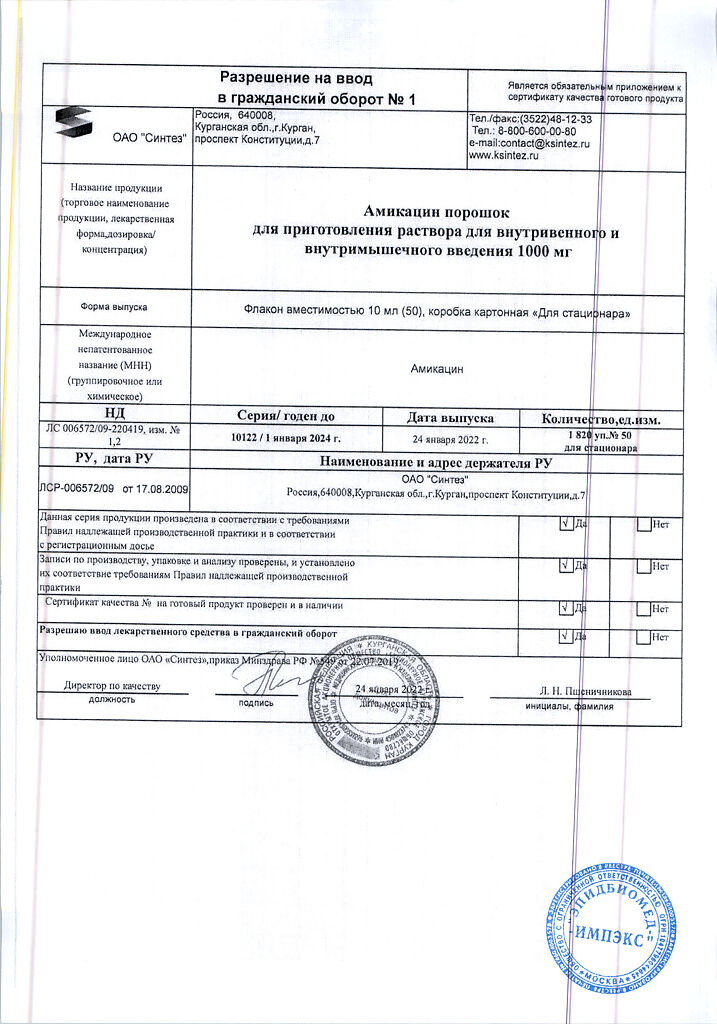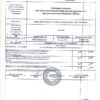No products in the cart.
Amikacin, 1000 mg 50 pcs
€1.00
Out of stock
(E-mail when Stock is available)
Description
Pharmacodynamics
Amikacin is a broad spectrum semi-synthetic antibiotic with bactericidal effect. Binding to 30S ribosome subunit it prevents formation of transport and matrix RNA complex, blocks protein synthesis and destroys cytoplasmic membranes of bacteria. Highly active against aerobic Gram-negative microorganisms – Pseudomonas aeruginosa, Escherichia coli, Klebsiella spp., Serratia spp., Providencia spp., Enterobacter spp., Salmonella spp, Shigella spp.; some Gram-positive microorganisms – Staphylococcus spp. (including those resistant to penicillin, some cephalosporins); moderately active against Streptococcus spp. When administered simultaneously with benzylpenicillin it has a synergistic effect against strains of Enterococcus faecalis. It has no effect on anaerobic microorganisms. Amikacin does not lose activity under the action of enzymes inactivating other aminoglycosides and may remain active against strains of Pseudomonas aeruginosa resistant to tobramycin, gentamicin and netilmicin.
Pharmacokinetics
After intramuscular administration, it is absorbed quickly and completely. The maximum concentration (Cmax) with intramuscular administration of 7.5 mg/kg is 21 µg/ml, after 30 minutes of nutriven infusion of 7.5 mg/kg is 38 µg/ml. Time of reaching maximum concentration (Tcmax) is about 1.5 h after intramuscular injection. Binding with plasma proteins is 4-11%. It is well distributed in extracellular fluid (abscess contents, pleural effusion, ascitic fluid, pericardial, synovial, lymphatic and peritoneal fluid); in high concentrations it is found in urine; in low concentrations in bile, breast milk, aqueous humor, bronchial secretion, sputum and cerebrospinal fluid (CSF). It penetrates well into all body tissues, where it accumulates intracellularly; high concentrations are noted in organs with good blood supply: lungs, liver, myocardium, spleen, and especially in kidneys, where it accumulates in cortical substance, lower concentrations – in muscles, adipose tissue and bones.
When administered in average therapeutic doses (normal) in adults amikacin does not penetrate the blood-brain barrier (BBB), in inflammation of the brain membranes permeability is slightly increased. Neonates reach higher concentrations in the CSF than adults; it passes through the placenta and is detected in fetal blood and amniotic fluid. Distribution volume in adults is 0.26 l/kg, in children – 0.2-0.4 l/kg, in neonates – less than 1 week old and weighing less than 1500 g – up to 0.68 l/kg, in those less than 1 week old and weighing more than 1500 g – up to 0.58 l/kg, in cystic fibrosis patients – 0.3-0.39 l/kg. Average therapeutic concentration is retained for 10-12 hours after intravenous or intravenous administration. It is not metabolized.
The half-life (T1/2) in adults is 2-4 hours, in infants – 5-8 hours, in older children – 2.5-4 hours. Final T1/2 is more than 100 hours (release from intracellular depots). It is excreted by the kidneys by glomerular filtration (65-94%) mainly unchanged. Renal clearance is 79-100 ml/min. T1/2 in adults with impaired renal function varies depending on the degree of impairment – up to 100 hours, in patients with cystic fibrosis – 1-2 hours, in patients with burns and hyperthermia T1/2 may be shorter than the average due to increased clearance. It is eliminated with hemodialysis (50% in 4-6 hours), peritoneal dialysis is less effective (25% in 48-72 hours).
Indications
Indications
Infectious and inflammatory diseases caused by Gram-negative microorganisms (resistant to gentamicin, sisomycin and kanamycin) or associations of Gram-positive and Gram-negative microorganisms:
Active ingredient
Active ingredient
Composition
Composition
The active ingredient is amikacin sulfate (in terms of amikacin) – 1000 mg.
How to take, the dosage
How to take, the dosage
Intramuscularly, intravenously (by stream, within 2 minutes, or by drip), adults and children over 6 years of age – 5 mg/kg every 8 hours or 7.5 mg/kg every 12 hours; bacterial urinary tract infections (uncomplicated) – 250 mg every 12 hours; after a hemodialysis session an additional dose of 3-5 mg/kg may be prescribed.
Maximal dose for adults is 15 mg/kg/day, but not more than 1.5 g/day during 10 days.
Treatment duration when administered by injection is 3-7 days; when administered by injection is 7-10 days.
To premature infants the initial dose is 10 mg/kg and then 7.5 mg/kg every 18-24 hours; to newborns and children under 6 years old the initial dose is 10 mg/kg and then 7.5 mg/kg every 12 hours for 7-10 days.
Burn patients may require a dose of 5-7.5 mg/kg every 4-6 h due to the shorter T1/2 (1-1.5 h) in these patients.
For intramuscular administration a solution prepared by adding 2-3 ml of water for injection to the contents of 250 mg or 500 mg vial.
Intravenous amikacin is infused by dropwise infusion for 30-60 minutes, if necessary – by trickle infusion.
For intravenous (trickle) infusion a solution prepared by adding to the content of the bottle of 250 mg or 500 mg 2-3 ml of water for injections or 0.9 % sodium chloride solution or 5 % dextrose solution is used.
For intravenous administration (dropwise) the content of the bottle is dissolved in 200 ml of 5% dextrose solution or 0.9% sodium chloride solution.
The concentration of amikacin in solution for intravenous administration should not exceed 5 mg/ml.
Interaction
Interaction
Pharmaceutically incompatible with penicillins, heparin, cephalosporins, capreomycin, amphotericin B, hydrochlorothiazide, erythromycin, nitrofurantoin, vitamins B and C, potassium chloride. It shows synergism in interaction with carbenicillin, benzylpenicillin, cephalosporins (in patients with severe chronic renal insufficiency when used together with beta-lactam antibiotics the effectiveness of aminoglycosides may decrease).
Nalidixic acid, polymyxin B, cisplatin and vancomycin increase the risk of ototoxicity and nephrotoxicity. Diuretics (especially furosemide), cephalosporins, penicillins, sulfonamides and non-steroidal anti-inflammatory drugs, competing for active secretion in nephron tubules, block elimination of aminoglycosides, increase their serum concentrations, increasing nephro- and neurotoxicity. Increases the myorelaxant effect of curare-like drugs.
Methoxyflurane, polymyxins for parenteral administration, capreomycin and other drugs that block neuromuscular transmission (halogenated hydrocarbons as drugs for inhalation anesthesia, opioid analgesics), transfusion of large amounts of blood with citrate preservatives increase the risk of respiratory arrest. Parenteral administration of indomethacin increases the risk of toxic effects of aminoglycosides (increased elimination half-life and decreased clearance). Reduces the effect of antimiasthenic drugs.
Special Instructions
Special Instructions
The sensitivity of isolated pathogens is determined before use using discs containing 30 µg amikacin. When the diameter of the growth-free zone is 17 mm or more, the microorganism is considered sensitive, from 15 to 16 mm – moderately sensitive, less than 14 mm – resistant. The concentration of amikacin in plasma should not exceed 25 µg/ml (therapeutic concentration is 15-25 µg/ml).
During treatment, renal, auditory nerve and vestibular function should be monitored at least once a week. The probability of nephrotoxicity is higher in patients with impaired renal function, as well as when prescribing high doses or for a long time (daily monitoring of renal function may be required in this category of patients). If audiometric tests are unsatisfactory, the dose of the drug is decreased or treatment is stopped.
Patients with infectious inflammatory diseases of the urinary tract are recommended to take increased amounts of fluids. In the absence of positive clinical dynamics it should be remembered about the possibility of development of resistant microorganisms. In such cases, it is necessary to cancel the treatment and initiate appropriate therapy. In case of vital indications the drug may be used in breastfeeding women (aminoglycosides penetrate into breast milk in small quantities, however, they are poorly absorbed from the gastrointestinal tract, and complications associated with them in breastfed children have not been reported).
Contraindications
Contraindications
With caution – myasthenia gravis, parkinsonism, botulism (aminoglycosides may cause disruption of neuromuscular transmission, which leads to further weakening of skeletal muscles), dehydration, renal failure, newborn period, premature children, old age, lactation period.
Side effects
Side effects
Digestive system disorders: nausea, vomiting, liver dysfunction (increased activity of “hepatic” transaminases, hyperbilirubinemia).
Hematopoietic disorders: anemia, leukopenia, granulocytopenia, thrombocytopenia.
Nervous system disorders: headache, somnolence, neurotoxic effect (muscle twitching, numbness, tingling sensation, epileptic seizures), violation of neuromuscular transmission (respiratory arrest).
Senses: ototoxicity (decreased hearing, vestibular and labyrinthine disorders, irreversible deafness), toxic effects on the vestibular system (discoordination of movements, dizziness, nausea, vomiting).
More urinary system disorders: nephrotoxicity – renal dysfunction (oliguria, proteinuria, microhematuria).
Allergic reactions: skin rash, itching, skin hyperemia, fever, Quincke’s edema.
Local: pain at the injection site, dermatitis, phlebitis and periphlebitis (when administered intravenously).
Overdose
Overdose
Symptoms: toxic reactions (hearing loss, ataxia, dizziness, urinary disorders, thirst, decreased appetite, nausea, vomiting, ringing or tinnitus, respiratory disorders).
Treatment: hemodialysis or peritoneal dialysis to relieve neuromuscular transmission blockade and its consequences; anticholinesterase agents, calcium salts (Ca2+), artificial ventilation, other symptomatic and supportive therapy.
Additional information
| Shelf life | 2 years |
|---|---|
| Conditions of storage | In a dry, light-protected place at a temperature not exceeding 25 °C |
| Manufacturer | Sintez OAO, Russia |
| Medication form | Powder for preparation of solution |
| Brand | Sintez OAO |
Related products
Buy Amikacin, 1000 mg 50 pcs with delivery to USA, UK, Europe and over 120 other countries.























